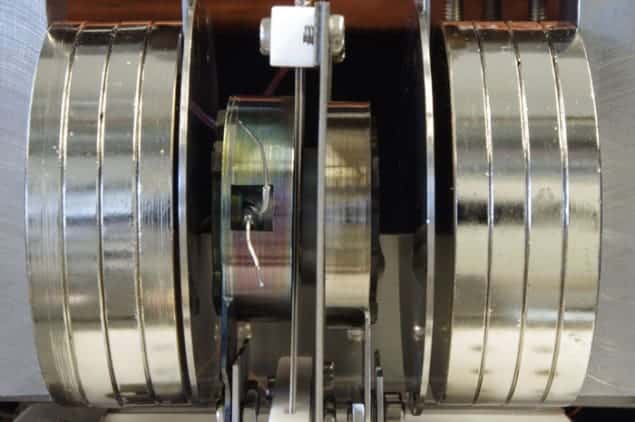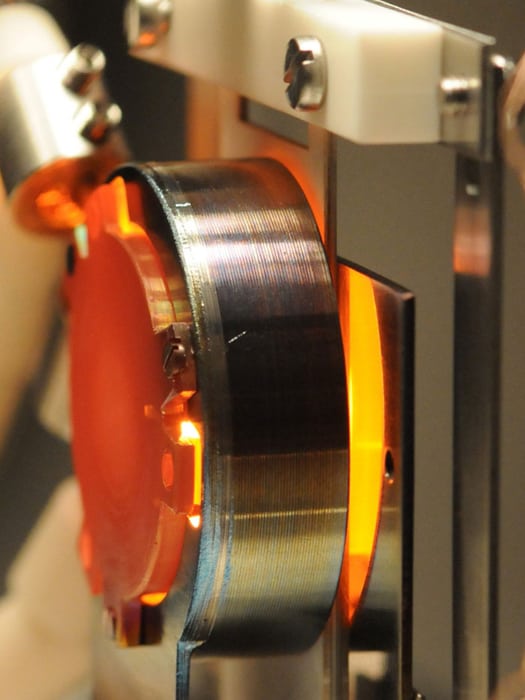
A new type of thermionic generator that turns heat or light into electrical energy has been developed by researchers in Germany and the US. The new design overcomes the “space-charge problem” that has plagued previous attempts at developing practical devices. The device is about four times more efficient than previous generators and the new technology could find use in a range of applications including solar power and the harvesting of waste heat.
Thermionic generators convert heat or light into an electric current by using the temperature difference between two metallic plates that are separated by a vacuum. The “hot” plate is heated either by incident light or thermal conduction and this causes electrons to evaporate from its surface. These electrons then condense on the surface of the cold plate. This creates a charge difference between the two plates, which can drive a usable electric current.
Because they convert heat or light directly into electrical energy, thermionic generators have considerable potential for practical applications. If used in coal-fired power stations, for example, thermionic converters would, in principle, be more efficient than steam turbines. Thermionic generators could also be applied to a variety of lower-temperature applications, such as the collection of solar energy or the recycling of waste heat in car engines.
The space-charge problem
While this potential for highly efficient energy conversion has been known since the late 1950s, the practical applications have been severely limited by what is called the space-charge problem. For plates separated by more than about 3–5 μm, the negative charge of the “cloud” of electrons that forms in the gap inhibits subsequent electrons from being emitted from the hot plate. This effectively puts a halt to the flow of electrons between the plates. While reducing the gap between plates would help, making a generator with plates that maintain a separation of less than 3 μm at high temperatures is extremely challenging.

Previous efforts to solve the space-charge problem have mainly involved inserting caesium ions into the space between the two plates. The positive ions act to neutralize some of the offending charge, thus allowing more electrons to be released from the hot plate. While this approach has been used in the lightweight TOPAZ nuclear reactors that powered some Soviet satellites, it results in a drop in power output of about 50%.
Now, Jochen Mannhart of the Max Planck Institute for Solid State Research in Stuttgart – along with colleagues at the University of Augsburg and Stanford University – has come up with a new way of solving the space-charge problem by creating an electric field in the space between the plates. This field first accelerates the electrons leaving the hot plate and then slows them down as they approach the cold plate. The charge cloud is therefore moved along and does not repel subsequent electrons – allowing for a continuous current. The field itself is created by a honeycomb-patterned gate with hexagonal holes in it. The electrons are guided through the holes by applying a magnetic field between the plates.
A 40% efficiency could be possible
“Practical thermionic generators have reached efficiencies of about 10%. The theoretical predictions for our thermionic generators reach about 40%,” says Mannhart. This figure also incorporates the energy needed to create the electric field.
Mannhart and colleagues believe that commercialization of their design could take a further 5–20 years, depending on whether the application is high temperature or low temperature. For the latter, Mannhart says that further optimization of the converter would be needed.
Nicholas Melosh of Stanford University, who was not involved in this study, describes the work as a “clever new technique” to address the space-charge problem, adding that “while more development still needs to be done, this principle could create new devices to convert waste or solar-generated heat into useful electricity”.
Planar triode revival
Neil Fox of the University of Bristol in the UK points out that the new generator has similarities to a planar triode design tested at the Massachusetts Institute of Technology (MIT) in the late 1950s. This previous design had suffered from energy loses caused by electron–electron collisions and scattering. “[Mannhart and colleagues] have come up with a rather neat vertical triode structure that seeks to improve on the MIT device, by incorporating beam collimating concepts similar to those used in particle accelerators,” explains Fox. “The data presented…show that this magnetic triode is a significant improvement over a closed-spaced diode, but suggests that electron–electron collisions and scattering losses to the gate are still present.”
The team is now working to increase the efficiency of its generator design in two ways. First, it is building high-performance converters from existing semiconductor technologies. Second, it is optimizing its electrodes through the use of new materials, especially oxides, and nanotechnology.
The work is described in the Journal of Renewable and Sustainable Energy.



